#Nic stuff
Text
me: yeah I'm reading Monstrous Regiment for the first time
my friend: wait, the first time? I thought if any that's the book you *had* to have read before
me: nope, I transed my gender all by myself, didn't even need Terry Pratchett's help!
however if I could send one book back in time to my 12 year old self, it'd absolutely be that one
205 notes
·
View notes
Text
also, hey posting my art on AO3 was easy enough, I think I'm gonna upload all my nsfw art there just in case tumblr comes for me again
3 notes
·
View notes
Text
having watched today's Doctor Who Episode
I think a painting of Ncuti Gatwa is next on the cards 👀
5 notes
·
View notes
Text

im coping the best that i can, guys
(hey all!
this gets more and more notes every day, and while i’m flattered, i am a bit crestfallen that my most popular post is yet again a low effort meme.
i make art!! i write!! i sing!! while i’m not the greatest it would make my day for you to check out some of the pieces i put hours of effort into.
here’s a lil ineffable wives one i just finished and here’s a post season two angst oneshot i wrote. just a couple of examples of what i do.
so if this meme got a chuckle out of you, maybe stick around? i take requests and im almost always online! have a lovely day and i apologize for my lil tangent)
10K notes
·
View notes
Text

HC10 doodles from watching cleo and zeds videos!
#nics art#skizzleman#zombiecleo#zedaph#hermitcraft#hermitcraft s10#hermitcraft fanart#im loving the vibes of this season so far#im gonna try watching a frw hermits that i dont normally watch just for a bit to see their content and stuff#and honestly im probably going to be keeping up with cleos season lol
589 notes
·
View notes
Text
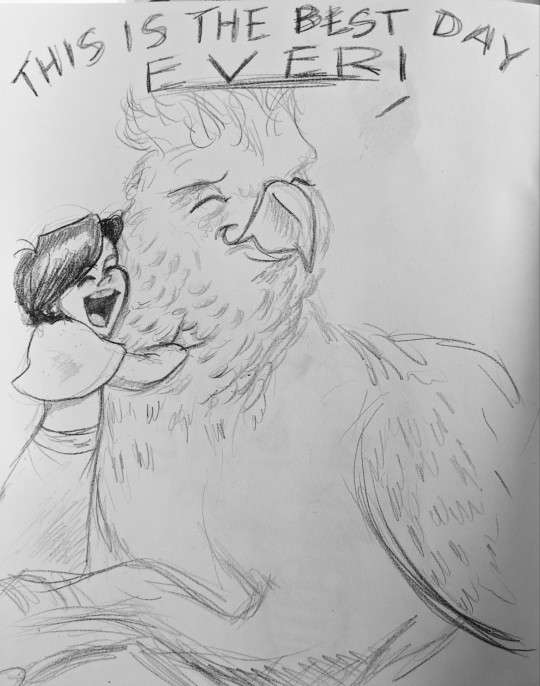
Sirius meets his first hippogriff!!!
@seriouslysam8
289 notes
·
View notes
Text
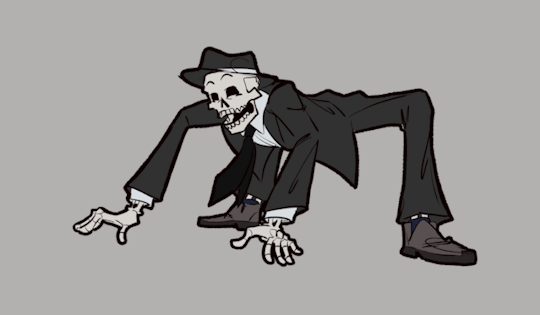
Get stickbugged skuldugged lol
hiding my unhinged thoughts in the tags
#i have never made something so stupid that made me smile so much#look at that fucker go#imagine him like#skedaddling towards you at top speed#hes the stuff of nightmares#necromancers beware#alternative: take#this is what he does on vals rooftop when she doesnt let him in#her neighbors have called the police but they never find anything#she is so done with him#im cackling please#someone put me in an institution#skulduggery pleasant#valkyrie cain#get stick bugged lol#stick bug#stick bug meme#meme#skulduggery pleasant memes#nic stylus
164 notes
·
View notes
Text
one of orv's most endearing aspects in my eyes is how well it often captures the essence of folk tales where a brave trickster outwits the devil. in that sense, it's the sort of story that a grandfather might tell his grandchild, making up tale after tale of the cunning character who can cheat his way out of any bind. let's hear how kim dokja enthralled the eater of dreams. let's hear how he won persephone to his side. let's hear the tale of how he climbed out of the stomach of a sea monster. we believe he is someone who can fight fate and someday win; after all, he's done it time and time again.
#nic's great orv reread#ORV'S FOLKTALE INFLUENCES ARE SO GOOD. THE GREEK TRAGEDY STUFF TIS ARC TOO...#its so good at understanding what makes all sorts of stories click to a reader and how to implement them#it is just really really good to read. so mechanically deft.
356 notes
·
View notes
Text
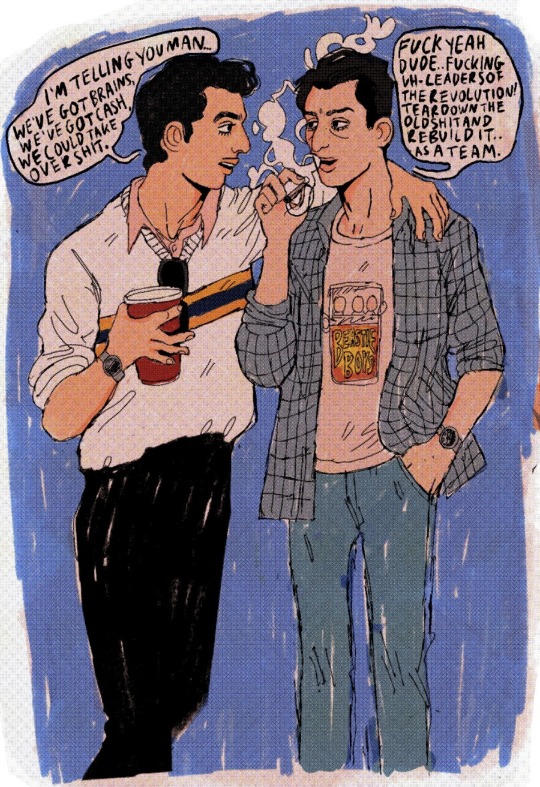

"be young, be dope, be proud, like an american"
comforting myself with some teenage!kenstewy scheming about taking over the world
#more to come . maybe#I feel very sad about succession and the Nic braun stuff and I haven't drawn for myself in a bit so here's this#praying for kenstewy to have a happy ending I am Hanging On By A Thread Right Now ...#kenstewy#kendall roy#stewy hosseini#succession#kendall x stewy#sorry. on a brighter note! im going back to a process I haven't done for a while#6b digital pencil under a print texture !! yumm#and then I put a half tone on it
793 notes
·
View notes
Text





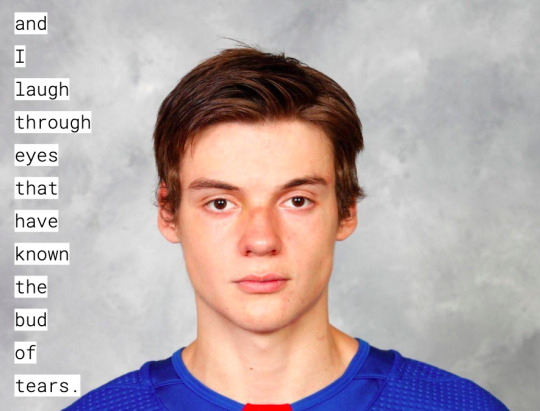

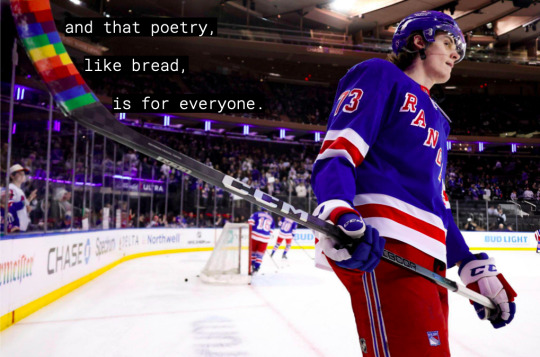

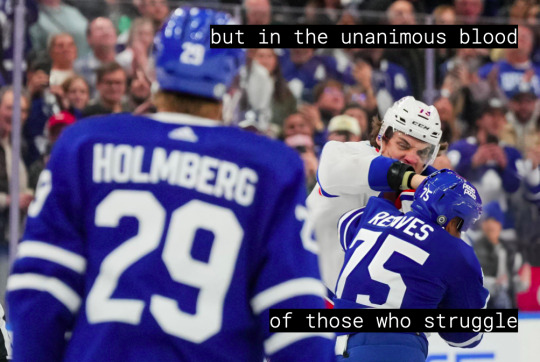





Matt Rempe // b. June 29, 2002
Derek Boogaard // b. June 23, 1982; d. May 13, 2011
Chris Simon // b. January 30, 1972; d. March 18, 2024
Rest in peace, Chris Simon.
Like You, Roque Dalton; translated by Jack Hirschman.
Michael Mooney / Tim Nwachukwu / Jared Silber / [screengrab] / Michael Mooney / Joshua Sarner / Len Redkoles / Jared Silber / Sarah Stier / Joshua Sarner / Michael Mooney / Chris Tanouye / Andre Ringuette / Paul Bereswill / Bruce Bennett / Bruce Kluckhohn / Jim McIsaac
#matt rempe#rangers#new york rangers#derek boogaard#chris simon#hockey poetry#my stuff#rest in peace chris simon this whole fucking thing is awful#i feel scared for like. nic deslauriers#reaves#rempe.#all the guys who are fighting now who like#in ten#fifteen years maybe#we're gonna hear some absolutely tragic shit about them
81 notes
·
View notes
Text
pokój Jakuba Adamczewskiego - krótka analiza programu ikonograficznego
(podstawą mojej analizy są ujęcia pokoju zaprezentowane przede wszystkim w epizodach 1, 3 i 4 oraz w filmiku "Welcome to my Dworek" z kanału Netflix na yt, mniej pomocniczy, ale równie warty obejrzenia jest filmik na instagramie Michała Sikorskiego (aktora wicelającego się w rolę Jakuba) "MTv Cribs x 1670" (michalsikorski.official))
Wygląda na to, że w pokoju Jakuba znajdują się cztery obrazy, pięć rzeźb i w ramie łóżka jedna płaskorzeźba.
Zacznijmy od obrazów:
Nad wejściem do jego pokoju, w miejscu, w którym tradycyjnie wiesza się krufcyfiks znajduje się obraz przedstawiający Chrystusa w typie Vir Dolorum (Męża Boleści) (czyli przedstawienie Chrystusa martwego lub zmartwychwstałego, eksponujące rany zadane mu podczas ukrzyżowania). To konkretne przedstawienie to reprodukcja obrazu z niderlandzkiego warsztatu Alberta Boutsa powstałego ok. 1525, znajdującego się w zbiorach The Met (The Man of Sorrows). [screen z 1 odcinka]


Takie przedstawienie Chrystusa ma swoje źródła w ikonografii bizantyjskiej, a w Europie Zachodniej swoją popularność zyskało w ramach propagowanej w późnym średniowieczu pobożności polegającej na uczuciowym rozmyślaniu o męce Chrystusa i tzn. "współodczuwaniu".
Drugi obraz wisi nad łóżkiem Jakuba oraz pojawia się w pierwszej po czołówce scenie w odcinku 4, gdy na chwilę Jakub wiesza go w pokoju Stanisława. Jest to reprodukcja obrazu przedstawiającego Świętego Franciszka z Asyżu włoskiego malarza Antoniazza Romano z lat 1480-81, obecnie w zbiorach The Met (Saint Francis of Assisi). [screeny kolejno z 4, 1 i 3 odcinka]


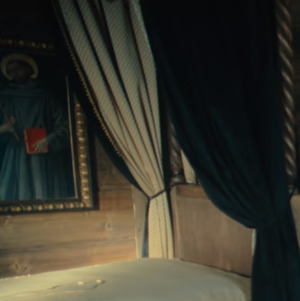

Święty Franciszek jest założycielem zakonu franciszkanów, który ukształtował w swoich pismach nowy rodzaj duchowości (duchowość franciszkańska), który charakteryzuje duża uczuciowość, wierne naśladowanie Chrystusa - zwłaszcza w aspekcie ubóstwa, bezwarunkowo miłość do bliźniego, a to wszystko połączone z radością życia i uwielbieniem Boga. Na obrazie święty prezentuje stygmaty na dłoniach i na boku.
Kolejne dwa obrazy wiszą nad biurkiem (kanonem?).
Pierwszy z nich, mniejszy i bliżej drzwi to reprodukcja obrazu hiszpańskiego malarza Franciso de Zurbarana z około 1640-45 przedstawiającego Świętego Benedykta z Nursji, znajdującego się w zbiorach The Met (Saint Benedict). [screeny z odcinka 3 i 1]

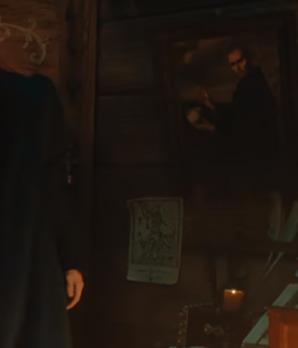
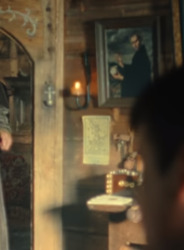
Świętemu Benedyktowi z Nursji przypisuje się autorstwo reguły benedyktyńskiej. Jest on jedynym z Ojców Kościoła i głównym patronem Europy.
Ostatni obraz wiszący obok obrazu ze świętym Benedyktem, to przedstawienie Hieronimity, Brata Gregorio Belo z włoskiego miasta Vicenza pędzla włoskiego malarza Lorenza Lotto z 1547 roku, obecnie w zbiorach The Met (Brother Gregorio Belo of Vicenza). [screeny z odcinka 1 oraz ze wspomnianego wyżej (i podlinkowanego) filmiku z instagrama Michała Sikorskiego]
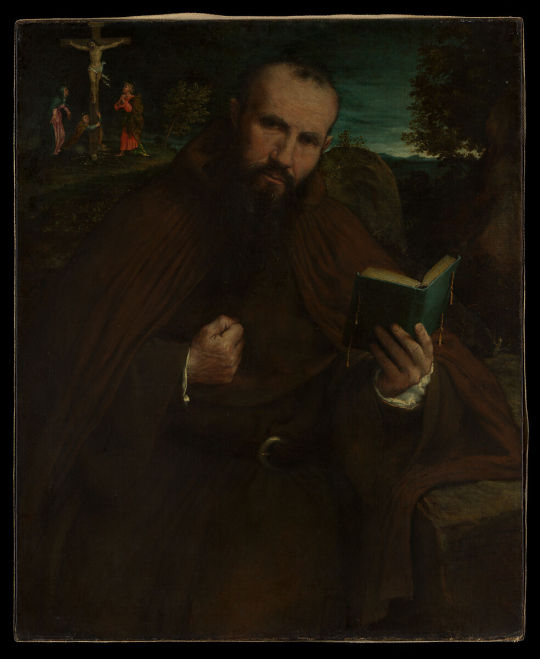
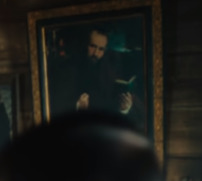

Zdaje się (co widać na screenie instagramowym), że na reprodukcji dodano nimb wokół głowy brata Gregoria. Zasadniczo nie jest to przedstawienie świętego - o bracie Gregoriu nic nie znalazłam i zdaje się, że jest to po prostu przedstawienie mnicha (Hieronimity) podczas pobożnej kontemplacji męki Chrystusa (która jako projekcja jego rozważań ukazana została w tle - tak przynajmniej podaje notka na stornie The Met) w ujęciu powielającym schemat, w którym najczęściej przedstawiano Świętego Hieronima ze Strydonu, założyciela kongregacji eremickiej, do której należał sportretowany.
Pięć rzeźb znajduje się w rogu pokoju na przeciw drzwi wejściowych, tworząc rodzaj "ołtarzyka" przed którym stoi klęcznik. Figury ustawione są na prostych, niepolichromowanych drewnianych konsolach. W odróżnieniu od obrazu rzeźba jest obiektem przestrzennym, co znacznie utrudnia wybór takowej do scenografii - z obrazami sprawa jest prosta - w ramy wsadza się reprodukcje, która pokryta werniksem albo po prostu pokazana w naturalnym świetle w oku kamery niewiele różni się od faktycznego obrazu. Tymczasem wykonanie przekonującej reprodukcji rzeźby drewnianej jest zdecydowanie trudniejszym i bardziej pracochłonnym zadaniem. Stąd, wydaje mi się, rzeźby te nie powtarzają żadnych znanych dzieł, a są po prostu rzeźbami prezentującymi szeroko przyjęte typy figur dewocyjnych, jakie cały czas można kupić do kościoła lub kaplicy (na przykład tutaj - niepolichromowane rzeźby drewniane również dewocyjne, całkiem swoją drogą podobne do rzeźby środkowej). [screeny z odcinka 1 i z filmiku "Welcome to my Dworek"]

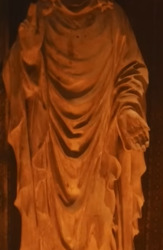
Rzeźba środkowa przedstawia Chrystusa błogosławiącego i jest jedyną rzeźbą niepolichromowaną.
Pierwsza od lewej jest Maria z dzieciątkiem, następnie Święty Antoni Padewski (?), franciszkanin i cudo twórca (znajomy Świętego Franciszka z Asyżu), patron osób i rzeczy zaginionych, dzieci, małżeństw i narzeczeństw (według ludowej tradycji pomagający dziewczętom znaleźć dobrych narzeczonych). W ikonografii przedstawiany często (tak jak na naszym przykładzie) z Dzieciątkiem Jezus na ręce (wtedy zwykle w drugiej trzyma kwiat lilii - tutaj tego nie ma, nasz święty trzyma chyba coś innego, ale nie jestem w stanie powiedzieć, co to jest, stąd trochę niepewne rozpoznanie). [screeny z filmiku "Welcome to my Dworek"]


Na prawo od dużej rzeźby Chrystusa znajduje się najpierw rzeźba Świętego Piotra - następcy Chrystusa jako głowy kościoła i tym samym pierwszego biskupa Rzymu. Święty Piotr jest uważany za najważniejszego spośród dwunastu apostołów, któremu Chrystus przekazał władzę nad Kościołem na Ziemi, co realizuje się w motywie przekazania Piotrowi przez Chrystusa kluczy - stąd klucz jako najbardziej rozpowszechniony atrybut tego świętego, widoczny również w dłoni naszej rzeźby. Ostatnia rzeźba na prawo to Święty Paweł (?) - rozpoznanie to opieram na trzymanym przez postać mieczu (stałym atrybucie Świętego Pawła), dodatkowo Paweł jest w ikonografii nadzwyczaj często przedstawiany właśnie wraz z Piotrem. Święty Paweł jest wedle tradycji uważany za Apostoła Narodów (choć formalnie nie był nigdy uczniem Jezusa; nawrócił się po jego Wniebowstąpieniu), jest również uważany za autora 1 Listu do Koryntian, którego fragmentem jest tzn. "Hymn o Miłości". [screeny z filmiku "Welcome do my Dworek" oraz z odcinka 4]

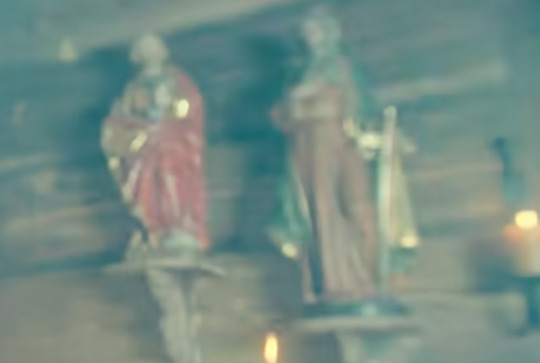
Oczywiście z dużym prawdopodobieństwem każda z tych rzeźba jest powieleniem lub odległym echem jakiejś stosunkowo znanej kompozycji; ich dokładne opisanie i rozpoznanie pozostaje sprawą otwartą.
Jak już wspomniałam w pokoju Jakuba znajduje się jeszcze, w wezgłowiu łóżka płaskorzeźba. Przedstawia ona Świętego Jerzego podczas walki ze smokiem; jest to przedstawienie epizodu ze średniowiecznej legendy, często powtarzanej w średniowiecznych romansach. Święty Jerzy jest patron rolników, pasterzy i pól (jego dzień (23 albo 24 kwietnia) uważano za najlepszy dla rozpoczęcia prac polowych), pod jego patronatem powstało również wiele bractw rycerskich i zgromadzeń zakonnych oraz zakonów rycerskich. [screeny z odcinka 1 i 2]


Poza tym zlokalizować można w pokoju Jakuba dwa (?) krucyfiksy; jeden stoi na kominku i jest to prosty w swojej formie, drewniany krzyż na podwyższeniu. Co do drugiego (krzyż również drewniany, ale z polichromowanym wizerunkiem Chrystusa, wiszący a nie stojący), to sprawa jest trochę bardziej skomplikowana, ponieważ widzimy go tylko w filmiku "Welcome to my Dworek", w pojedynczy, kadrze, nie widzimy go jednak ani razu w szerszym ujęciu pokoju; stąd wniosek, że jeśli w ogóle już się tam faktycznie znajduje, to musi wisieć między łóżkiem a drzwiami, w miejscu, którego ani razu nie widzimy, ponieważ zasłania je otwarte skrzydło drzwi. [screeny z filmiku "Welcome to my Dworek"]
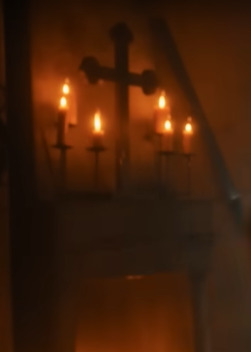

Wnioski
Trzeba przyznać, że po tej analizie wnioski są marne. Zdaje się, że obecne w pokoju Jakuba obrazy i rzeźby ani nie układają się w żaden przemyślany program ikonograficzny ani nie stanowią grupy precyzyjnie wybranej (O zaskoczenie!).
Najbardziej "pasujący" do konwencji tych wszystkich narzędzi "pokutnych" obecnych w pokoju Jakuba i sugerowanego tym samym zainteresowania cierpieniem wydaje mi się obraz Vir dolorum wiszący nad drzwiami i być może dlatego właśnie on jest w serialu najlepiej wyeksponowany.
Obraz z przedstawieniem Świętego Franciszka jest dla mnie zagadką, ponieważ zarówno to, że w swoim "stanie spoczynku" wisi nad łóżkiem Jakuba oraz to, że jest jak gdyby "obrazem symbolem" użytym w momencie, w którym Jakub chce pokazać, że zastąpi Stanisława w jego roli dziedzica (Stanisława reprezentuje tam obraz przedstawiający gitarzystę), wydaje się sugerować jakieś szczególne znaczenie tego przedstawienia dla Jakuba lub szczególne jego znaczenie jako "oznaczającego" Jakuba. Stąd zresztą w pierwszej chwili, bez przyjrzenia się i bez kwerendy uznałam, że to pewnie przedstawienie Świętego Jakuba - wtedy analogia, jako że obraz przedstawiał by patrona Jakuba, jego świętego imiennika, była by oczywista. Tymczasem przynajmniej bazując na tym co wiemy, nie da się w tym miejscu wytłumaczyć Świętego Franciszka.
(btw czy ktoś wie, czy w czasach nowożytnych określenie "Ojciec" było, tak jak dziś zarezerwowane jedynie dla zakonników-kapłanów czy zwyczajowo mówiło się tak też do księży spoza zgromadzeń zakonnych?)
Z tym, że choć ewentualna przynależność do zgromadzenia zakonnego, mogłaby tłumaczyć portret Świętego Franciszka (należałoby założyć wtedy przynależność Jakuba do zgromadzenia franciszkańskiego), to należy uwzględnić jeszcze przedstawienie Świętego Benedykta nad biurkiem, które równie dobrze mogłoby sugerować przynależność do benedyktynów. Poza tym brak w moim odczuciu jakiś oznak pobożności franciszkańskiej w Jakubie (ktoś by mnie zapytał czy widać jakąkolwiek pobożność, ale zdaje mi się, że bardziej valid byłaby próba powiązania go np. z bardziej jezuickim podejściem do sprawy (ale jezuitów brak pośród przedstawień w pokoju)). Może przewaga świętych franciszkańskich (Franciszek i rzeźba Antoniego Padewskiego) faktycznie coś sugeruje, ale wydaje mi się to raczej mało prawdopodobne biorąc pod uwagę całokształt.
Wspomniałam już o Świętym Benedykcie, co zaś do obrazu obok przedstawiającego brata Gregoria to w ogóle nie mam nic do powiedzenia poza tym, że wygląda to dla mnie na wybór całkowicie przypadkowy.
Moja teoria dotycząca obrazów jest dość prosta - być może Netflix ma umowę z The Met, która zezwala na dowolne użycie ich reprodukcji ich zbiorów w produkcjach Netflixa i tym samym jedynym, kryterium wyboru była przynależność do kolekcji The Met (choć chyba dałoby się wybrać lepiej).
Co do rzeźb to tak, jak już poniekąd napisałam, podejrzewam, że ich wybór odbył się na zasadzie "to co w miarę łatwo pozyskać to weźmiemy". Podobnie pewnie było z łóżkiem, bo nie podejrzewam, żeby płaskorzeźba była tam wtórnie wstawiona.
Oczywiście obecność każdego z przedstawień da się jakoś tam wytłumaczyć wewnątrz lore - najprostszym sposobem na to może być "Jakuba tak naprawdę w ogóle nie interesuje jakie obrazy wiszą w jego pokoju i jakie rzeźby tam stoją i zostały przez niego wybrane na chybił trafił" (chociaż dręczyć w tym ujęciu i tak będzie mnie ten Święty Franciszek).
Ale ja bym rzecz jasna wolała, żeby jakieś szersze ikonograficzne znaczenie w tym wszystkim było, a chyba go nie ma.
(W opisie pojedynczych obiektów starałam się mimo to w większości uwypuklić te ich znaczenia, które można jakoś zinterpretować na korzyść).
[edit - dalsze przemyślenia]
Jeśli teoria o ograniczeniu wyboru dzieł do zbiorów The Met narzuconym przez Netflix jest prawdziwa (czas zbudować hipotezę na hipotezie), to po dość szybkim ale chyba całkiem dokładnym obejrzeniu zbiorów The Met malarstwa Europejskiego (a te w przedziale lat 1300-1670 nie robią niestety zbyt wielkiego wrażenia) zaczynam chyba rozumieć modus operandi. Przede wszystkim wybór zawężono (dość mocno) do przedstawień portretowych, rezygnując z wybrania obrazów ukazujących epizody z historii świętej lub z życia świętych, ograniczając się zdaje się do zasady „jeden obraz - jedna postać, i to najlepiej nie wykonująca żadnej czynności” (decyzja, którą nie do końca umiem sobie wytłumaczyć!). Po drugie odrzucono wizerunki. Marii z dzieciątkiem, których w zbiorach The Met mnóstwo, zakładam, że w ramach większej „maskulinizacji” przestrzeni (że tak powiem) (wszak jedna tylko rzeźba Marii się pojawia, ale wyjątek potwierdza regułę i jedna jaskółka wiosny nie czyni). Po trzecie zdaje się, że odrzucono pomysł powtórzenia obecności jednej postaci (poza Chrystusem) dwukrotnie, co najpewniej sprawiło, że odrzucono obrazy przedstawiające Świętego Franciszka Frederica Barocciego i Il Grechetta, które są ładniejsze (ciekawsze!) i zdają się bardziej sensowne niż ten portret brata Gregoria, ale najwyraźniej, mimo że postać Franciszka podkreślono (pewnie wcale nie celowo), to najwyraźniej nikt nie chciał w to brnąć jeszcze bardziej.
Fajny też obraz Filippa Tarchiani przedstawiający samobiczującego się Świętego Dominika odrzucono być może ze względu na częściową goliznę świętego.
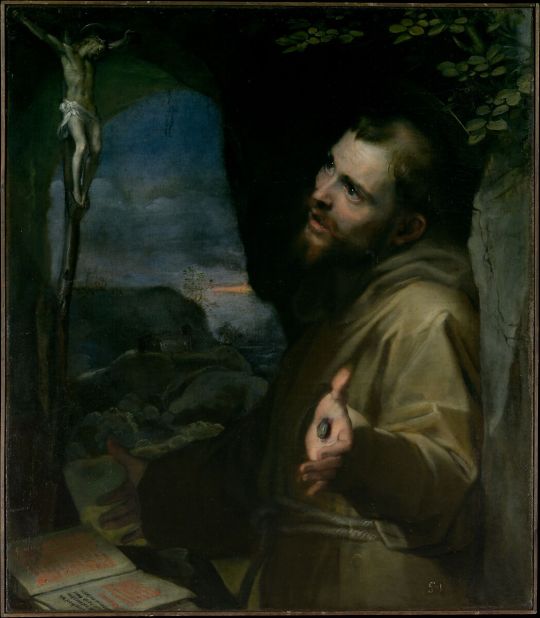
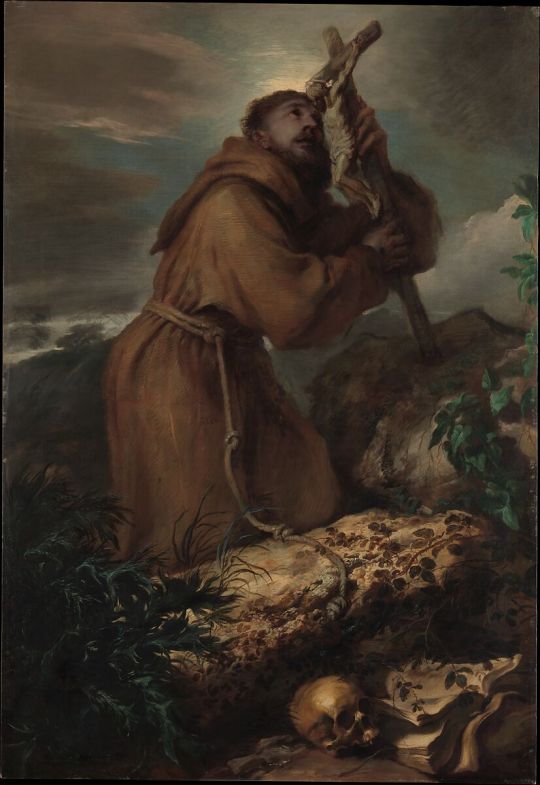

W tak zawężonej grupie dokonany przez scenarzystów (albo kogoś tam) wybór (przypominam tylko przy założeniu konieczności wybrania dzieł z The Met!) staje się zrozumiały.
Dziękuję za uwagę! :)
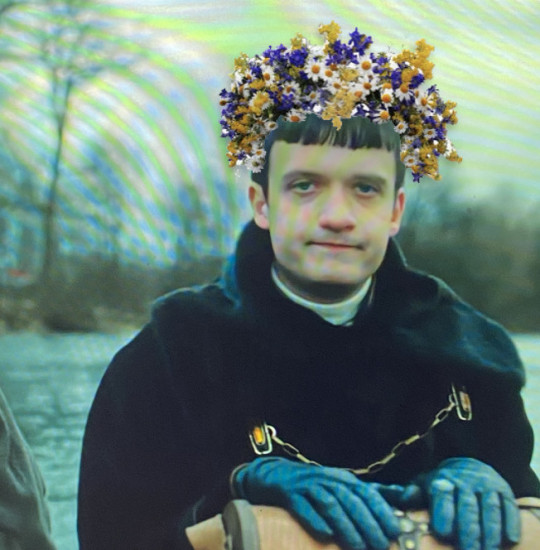
#proszę jak ktoś wie coś więcej mi to wyartykułować to się postaram to uwzględnić poza tym zawsze miło posłuchać mądrzejszego#trochę lacking in the history department#ktoś mógłby to wszystko sprostować jeśli ma większą wiedzę na ten temat#zupełnie nikomu niepotrzebna analiza#zamiast pisania pracy licencjackiej#jeśli jeszcze będzie mi się nudzić niedługo to zrobię alternatywny zestaw dzieł ale nic nie obiecuję#1670#1670 netflix#jakub adamczewski#ikonografia#ikonografia chrześcijańska#the met#the metropolitan museum of art#polish stuff#jan paweł adamczewski#stanisław adamczewski#coraz bardziej chcę zrobić alternatywny zestaw - z met#ale też taki z obrazami z innych kolekcji#trzynaście tysięcy znaków wtf#1670 rant
74 notes
·
View notes
Text
bi4bi until proven straight
97 notes
·
View notes
Text
In other news, today I broke out my gouache paints for the first time in two years for an exciting @sponeszine piece, so watch this space! 👀 (and go follow them, bc I won't be sharing the art myself until the zine has launched)
5 notes
·
View notes
Text
nex benedict was a native american non binary kid who was beaten to death in the girls bathroom at their school in oklahoma. the school forced them to use the girls room and they still got fucking killed.
their school didnt even call 911 when they were dizzy and bruised and bleeding after being assaulted by three older girls and having their head slammed on the tile floor. they were suspended for two weeks. they died from the head injuries 24 hours later.
NEX WAS SIXTEEN. SIXTEEN. THEY LIKED MINECRAFT AND ARK SURVIVAL EVOLVED AND THEIR CAT ZEUS.
THEY WERE A CHILD.
THEY WERE TOLD TO COMPLY TO THE RULES ABOUT BATHROOMS AND THEY DID AND THEY WERE STILL BEATEN TO DEATH. BECAUSE IT HAS NEVER BEEN ABOUT BATHROOMS AND BIOLOGICAL SEX. IT IS ABOUT SILENCING AND ENDING US.
trans kids are not safe anywhere. terfs and transphobic influencers teach children to hate their peers and people DIE. i hope terfs know that they are the reason people die. nex's blood, and the blood of thousands of trans kids who have been killed, abused, and ended their own lives, are on your hands.
im disgusted and depressed and scared
important additions!!
@donuteater13 added this link to a source
@wonderthestars compiled this info:

as @minecraft666 said, the staff needs to be held accountable for not calling an ambulance and allowing the transphobia to exist


https://ohs.owassops.org/apps/staff/
#tw violence#tw murder#tw transphobia#nics stuff#lgbt#lgbtq#lgbtq+#trans#transgender#nonbinary#nex benedict#justice for nex benedict#trans rights
3K notes
·
View notes
Text
so i was talking with my friend abt like-- genshin lore and it got to the subject of forbidden knowledge and stuff
and she used this analogy of it being a computer virus or a corrupted file that cant be processed properly
which then made me think "ahaha yes SAGAU IDEA--"
so what if... the forbidden knowledge was the fact that the world is a game/simulation? and since the world of genshin is a computer program, it wasnt built to handle the realization of the nature of its existence and like-- processed it as eleazar, and "forbidden knowledge" and its other effects on the world
eleazar is the system like-- turning it into the safest thing the program can handle and leaving it to the gods (rukk and desh) to try and fully put a stop to it like anti-virus-- the program is only running the world, not the beings and people in it, so itd make sense for them to stop it since when the world is ending and you can do something about it, youd probably do something about it--
since rukk and desh were gods and therefore much "closer" to the games code/programming (closer in the sense that they were much more directly tied/connected to it-- esp rukkha because of irminsul), they were able to handle the realization in a sense-- like... they knew that they werent "real" in some sense and knew that this knowledge is slowly killing them and their deaths to the knowledge that "they werent real" is inevitable and that-- in a way, the eleazar is one of the safest ways for people to handle the knowledge-- that even the world is protecting them from the ruin of it
i imagine the way the two gods processed the information was like-- thru the "corruptive qualities of forbidden knowledge" and in fragmented parts. its why i said that they only knew that they werent "real" and not that they knew that theyre a video game world-- kind of in the same vein of practically every harbinger going "the sky is fake let me tell you about it" (proceeds to not tell you about it) (dottore i love you but im still mad about it)
but if the "forbidden knowledge" is knowledge about how youre not real because youre a video game and youre not supposed to be self aware of it, how then can the harbingers handle that information without going mad or constantly dying of eleazar? i mean-- in the both the manga and in the game its pretty explicitly said that like, dottore fully stopped colleis eleazar and practically cured her of it.
so... you know how they manage to keep altered information in the form of stories in scaramouches archon quest? i think a similar case happened here-- an allegorical story about people living in a fake reality, be it a dream or a story or something, was made to preserve this information. and since it wasnt the pure unadulterated truth about the nature of this worlds existence anymore, the program could handle it and keep anyone from reading it suffering the negative effects of forbidden knowledge
pierro probably did it tbh-- in the archon quest, it was said that the events of khaenriah and the events leading to the deaths of king deshret and rukkhadevata are similar, if not exactly the same.
so how can we then tie this into SAGAU? are you still with me? did you completely forget that this is about me bullshitting the games lore so much to fit this really specific genre of genshin fandom stuff so you can make content about it? have you forgotten i write SAGAU fics? ...honestly i cant blame you for that last one if you did, i havent been writing SAGAU fic in a WHILE LMAO
ANYWAYS--
the concept of "forbidden knowledge" being used in SAGAU is really interesting which is why im writing abt it in the first place lmao-- and the concept is uber fun so this is just me helping you fit this into your own fics and fanworks
since the "forbidden knowledge" is literally just like "youre a computer program and youre not supposed to know that", y/n would DEFINITELY be able to handle it without the adverse effects. and i know that y/n is basically the equivalent of a mary sue at this point and it physically hurted me when i started writing y/n fics but-- if you think abt it, it makes sense
i am trying so hard rn to like-- not turn this into a discussion about mary sues-- just watch OSPs video on the subject and youre golden lmao
it makes sense for y/n to be able to handle it because number one: y/n is literally us. y/n is not lines of code in a program. y/n is never supposed to end up inside a program or software, and is DEFINITELY SUPER AWARE OF THE FACT THAT GENSHIN IS NOT REAL.
y/n is a human, or at least was a human before they got isekaied or whatever plot thing you decide to do to put y/n in the genshi world. y/n is human, not programming and can definitely handle the thought of "youre not real, youre a game". (lmao it could also really make for some good introspection and/or angst moments where they could philosophize about themselves now that theyre in the game, and the nature of pataphysics and all that fun stuff lmao)
i feel like-- you could also use this as like, a sort of leverage thing? to prove that you are who you say you are and, if this is impostor au, you could use it to your advantage as well in more aggressive ways-- not just as a "prove that youre the one above us all" situation but as a sort of self defence thing-- like when scara and dottore were both talking about the sky being fake thing
obviously youd be immune to eleazar and the madness of the forbidden knowledge caps and the other adverse effects-- BUT you could also inflict those things to the people and the world around you. while other characters like the fatui and the gods could say "youre fake, the world isnt real", they wont inflict the bad stuff since its like they heard the info from a friend of a friend of a friend-- the knowledge has been filtered and purified and fragmented so much that it wont do anything-- its not the full unadulterated truth
but when y/n says it, thats when it inflicts the adverse effects. its the difference between knowing something happened because you were there when it happened and witnessed it, and knowing something happened because you heard it happen from a friend who found out thru the internet. y/n fully knows the truth and intricacies of that statement on so many different levels than the characters can comprehend which is why they can do that.
i feel like it could depend with the volume and amount of people that heard-- like, if you scream it and a whole crowd hears you, the ones closest to you suffer the worst cases of eleazar ever recorded or EVEN DIE, and the severity just decreases the further it gets away from you. itd also be an instant withering zone or become something like the mud from the chasm
i also wanna say that you can "control" the spread in a way but like-- i dont see a way of making that happen tbh. if youre reading this and are getting inspo, go wild babes-- i believe in you, but i personally dont believe that y/n can control it. using the "computer virus" analogy, youd probably have to go into the essence of Teyvat itself to "delete that information" similarly to irminsul but different in the sense of like-- irminsul only put it in the recycle bin but youre going in the recycle bin, selecting all instances and deleting it. maybe you can bullshit it via leylines and abyss mage drops since they carry around leyline branches but i personally think that you just spew out forbidden knowledge, and have to go to irminsul itself to delete it
but yeah! thats my thoughs on Forbidden Knowledge in SAGAU and how it could fit into the world of the AU! making this actually like-- inspired me a bit to write again lmao-- theres just like, so many cool ass concepts in genshin that i dont see in this AU (probably because i havent been there in a while ;vjklldxfg) and i really hope you guys get inspired too :))
#but yeah lmao this is literally just me bullshitting lore so much to make it fit into-- at this point a whole ass genre of gensh content#if my friend sees this-- high probability of it happening btw-- hey man--#am i sorry that i turned our lore talk into genshin au bullshit?... nahhhhh#im just here to have fun and live my life lmao#and if that means desecrating lore to suit my own worldbuilding purposes? then so be it AHAHAHAH#but yeah!! it really like-- made we wanna deep dive into the lore again#both to use in fandom stuff and to just know#my thirst for knowledge will never be quenched ;CJKSDL;jVN#genshin impact#genshin#sagau#genshin sagau#genshin impact sagau#nic talks#genshin impact self aware#genshin self aware#genshin au
161 notes
·
View notes